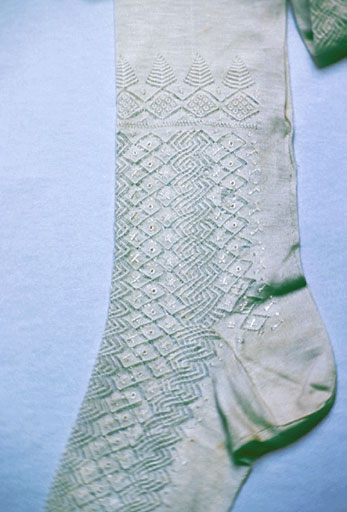stockings
Summary
Stockings with openwork knitted clocks in the lace lattice patterns, with a row of fir trees knitted around the ankle. the lattice is embroidered with eyelets and crosses in floss silk thread.
Display Label
Women's stockings in the nineteenth century were usually white or cream, although bright colours and vibrant stripes were also made. This is a typical pair from the middle years of the century in cream machine knitted silk with elaborate openwork decoration down the front calves. Silk was used for the best and most expensive stockings, relaced by rayon and later nylon in the twentieth century; cotton often mercerised and known as "lisle" was popular for cheaper, more hard-wearing examples, and was used well into the twentieth century (see brown Utility stockings below) . Until the early nineteenth century, hand knitters (see doll below) or stocking frame knitters (see print below), both working as outworkers in the home produced most of the stockings consumed in Britain, but by the middle of the nineteenth century, factory-based machinery had taken over from the traditional hand stocking makers of the eighteenth century, many of them based in northern areas like Yorkshire and Cumberland. Throughout the century, women's legs remained entirely concealed under ankle-length layers of skirt, petticoats, crinolines and bustles. Stockings were usually kept in place by garters at the knee, and suspenders attached to corsets were only introduced in about 1900.
Object Name
stockings
Date Created
1830-1850
Dimensions
Length: 59cm
Length of foot:
accession number
1983.636
Collection Group
Medium
Legal
© Manchester Art Gallery

